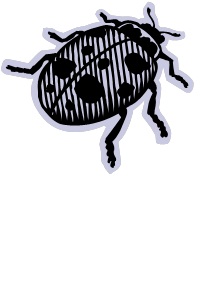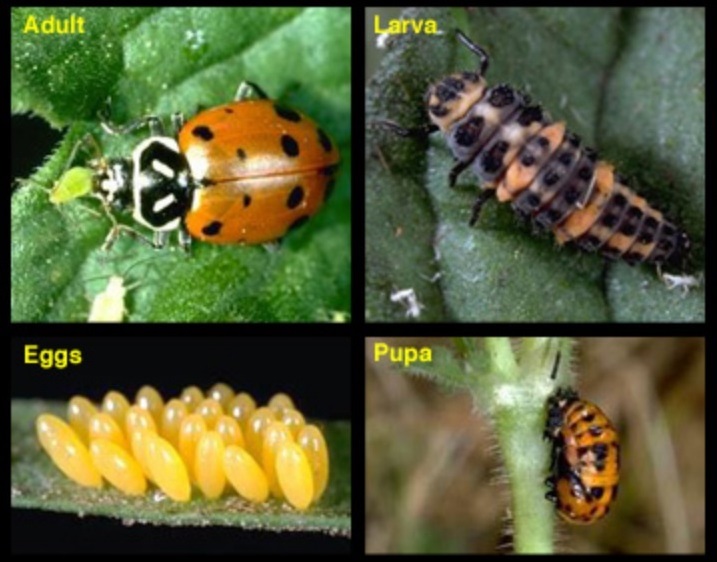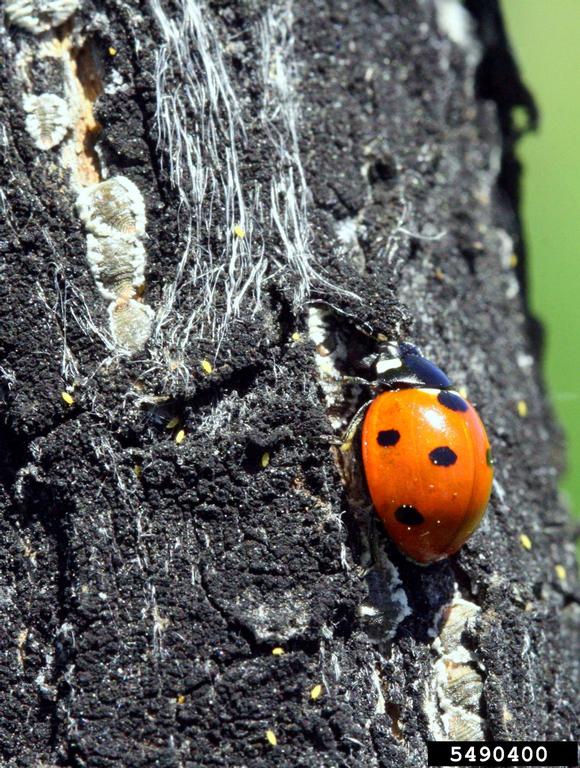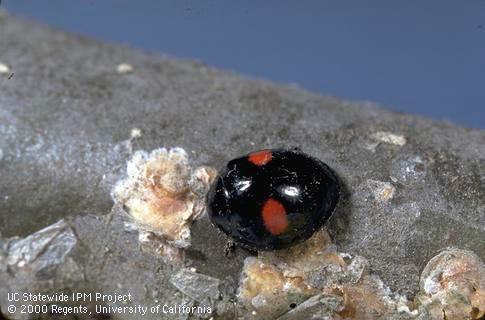 Lady Beetles - July 19, 2017 Jeff Schalau, Agent, Agriculture & Natural Resources University of Arizona Cooperative Extension, Yavapai County In spring, we reliably see aphids on succulent new plant growth. In fall, we may again see aphids on pines and other evergreens. If you donít actually see the aphids, you may notice the honeydew they exude. At its worst, aphid activity may result in the sidewalks, vehicles, and other objects being coated with shiny honeydew. The sugary honeydew is exuded by the aphids and can be washed off with water, but donít allow it to stay on painted surfaces for long because mold can grow and cause lasting damage. When aphid populations grow, aphid predators increase. Lady beetles are one type of aphid predator and their presence is generally visible. This predator/prey relationship is common and observable in our landscapes, gardens, orchards, and wildlands. Lady beetles, often called lady bugs, are the most commonly known of all beneficial insects. Both adults and larvae feed on many different soft-bodied insects with aphids being their main food source. Knowing that lady beetles will arrive in your garden helps you tolerate periodic aphid populations. Learning to recognize the eggs and stages of the lady beetle life cycle will help you monitor their populations and reduce unnecessary applications of insecticides. Most people recognize adult lady beetles by their shiny, convex, dome shape. They are often orange with black spots. However, given over 500 species found north of the Mexican border, there is much variation in color: from bright colors with spots to dark colors with few or no markings. Most lady beetles are predaceous as both larvae and adults and vary in adult body length between 3 to 7 mm. Aside from aphids, lady beetles can also feed on many other pests such as soft-scale insects, mealybugs, spider mites and eggs of the Colorado Potato Beetle and European Corn Borer. One lady beetle larva will eat about 400 medium-size aphids during its development to the pupal stage. An adult will eat about 300 medium-size aphids before it lays eggs. About three to ten aphids are eaten for each egg the beetle lays. More than 5,000 aphids may be eaten by a single adult in its lifetime. Usually the life cycle from egg to adult requires about three to four weeks, or up to six weeks during cooler spring months. In the spring, overwintering adult females find food, then lay from fifty to three hundred eggs in or near aphid colonies. Egg masses are small, bright orange ovals laid on end in groups. Eggs hatch in three to five days, and larvae feed on aphids or other insects for two to three weeks. Larvae are multi-colored, often mostly blue with red or orange markings and resemble little alligators (or in Arizona, Gila monsters). Larvae of most species go through four instars (stages between molts) looking similar but increasing in size each time before they pupate. The pupae are often attached to leaves, tree trunks, and structures and look similar to the larvae but are stationary and rounded. The pupae emerge as adults in seven to ten days. There may be five to six generations per year. Convergent lady beetles are one of the most common native species. The common name refers to a pair of white convergent dashes on the prothorax (the round plate behind the head). Another species is the twicestabbed lady beetle. The adults of this species are black with a red spot on each side of their back. Iíve included some links to more information and photos of several lady beetle species and life stages below. In Arizona, we have many other lady beetle species. Do not transport lady beetles from one place to another or purchase them to release in your garden. If there is food available or habitat is suitable, they will appear at the proper time. Furthermore, respect and conserve lady beetles (and other beneficial and/or benign insects) by only using insecticides when absolutely necessary and targeting the pest species as closely as possible to minimize impact to non-target organisms. Follow the Backyard Gardener on Twitter Ė use the link on the BYG website. If you have other gardening questions, call the Master Gardener help line in the Camp Verde office at 928-554-8992 or e-mail us at verdevalleymg@gmail.com and be sure to include your name, address and phone number. Find past Backyard Gardener columns or provide feedback at the Backyard Gardener web site: http://cals.arizona.edu/yavapai/anr/hort/byg/. Photos  Eggs, larva, pupa, and adult of convergent lady beetle. Photo by: Jack Kelly Clark, UC IPM, http://ipm.ucanr.edu/.
Eggs, larva, pupa, and adult of convergent lady beetle. Photo by: Jack Kelly Clark, UC IPM, http://ipm.ucanr.edu/. Adult seven spotted lady beetle (Chilocorus orbus). Photo by: Whitney Cranshaw, Bugwood.org.
Adult seven spotted lady beetle (Chilocorus orbus). Photo by: Whitney Cranshaw, Bugwood.org. Adult twicestabbed lady beetle (Coccinella septempunctata). Photo by: Jack Kelly Clark, UC IPM, http://ipm.ucanr.edu/.
Adult twicestabbed lady beetle (Coccinella septempunctata). Photo by: Jack Kelly Clark, UC IPM, http://ipm.ucanr.edu/.Additional Resources Lady Beetles Colorado State University Extension extension.colostate.edu/topic-areas/insects/lady-beetles-5-594/ Natural Enemies Gallery University of California IPM ipm.ucanr.edu/PMG/NE/ |